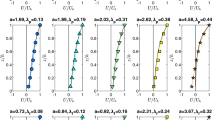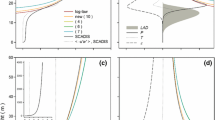Summary
An earlier paper showed that there is a growing need for increasingly accurate and reliable numerical models to predict optical turbulence conditions, especially in complex (nonuniform) signal propagation environments. Thus, we present a finite-difference computer model to demonstrate a viable approach for predicting the microphysical (microclimate) influences on optical turbulence intensity (C n 2) around the ARL A_LOT Facility and its surroundings (which consist of multiple building arrays and forests). Our multi-dimensional prototype model begins to address optical turbulence conditions along more complex lines-of-sight and begins to account for inhomogeneities in C n 2 brought about by horizontal changes in landscape, wind flow, temperature, and humidity. For now, the model physics represent advection, pressure gradient, eddy diffusion, and vegetation drag force processes. Simple mechanisms to predict the heat and moisture source terms have also been incorporated. Initial model results have been quite encouraging. The model code is computationally efficient and extremely flexible with regard to modifications and debugging. We anticipate that this kind of computational research will be an important vehicle for investigating C n 2 and related laser-optic propagation effects in complex areas.
Similar content being viewed by others
References
EL Andreas (1988) ArticleTitleEstimating C n 2 over snow and sea ice from meteorological data J Opt Soc Am 5 481–495
Beland RR (1993) Propagation through atmospheric turbulence. In: The Infrared Electro-optical Systems Handbook (Accetta JS, Shumaker DL, eds). SPIE Press Monograph, PM10, Bellingham, WA
B Blocken J Carmeliet (2004) ArticleTitlePedestrian wind environment around buildings: literature review and practical examples J Thermal Environ Building Sci 28 107–159 Occurrence Handle10.1177/1097196304044396
JA Businger JC Wyngaard Y Izumi EF Bradley (1971) ArticleTitleFlux-profile relationships in the atmospheric surface layer J Atmos Sci 28 181–189 Occurrence Handle10.1175/1520-0469(1971)028<0181:FPRITA>2.0.CO;2
T Chiba (1971) ArticleTitleSpot dancing of the laser beam propagated through the turbulent atmosphere Appl Optics 10 2456–2461 Occurrence Handle10.1364/AO.10.002456
AJ Dyer (1974) ArticleTitleA review of flux-profile relationships Bound Layer Meteorol 7 363–372 Occurrence Handle10.1007/BF00240838
JH Ferziger M Perić (2002) Computational methods for fluid dynamics EditionNumber3 Springer Berlin 423
DL Fried GE Mevers MP Keister (1967) ArticleTitleMeasurements of laser beam scintillation in the atmosphere J Opt Soc Am 57 787–797
JO Hinze (1975) Turbulence McGraw-Hill New York 800
JZ Holland (1989) ArticleTitleOn pressure-driven wind in deep forests J Appl Meteorol 28 1349–1355 Occurrence Handle10.1175/1520-0450(1989)028<1349:OPDWID>2.0.CO;2
RJ Hughes WT Buttler PG Kwiat SK Lamoreaux GL Morgan JE Nordholt CG Peterson (2000) ArticleTitleFree-space quantum key distribution J Mod Optic 47 549–562 Occurrence Handle10.1080/095003400148376
A Ishimaru (1978) The beam wave case and remote sensing Laser Beam Propagation in the Atmosphere Springer New York 129–170
NS Kopeika (1998) A system engineering approach to imaging SPIE Optical Engineering Press Bellingham, WA 679
Z Li JD Lin DR Miller (1990) ArticleTitleAir flow over and through a forest edge: a steady-state numerical simulation Bound Layer Meteorol 51 179–197 Occurrence Handle10.1007/BF00120467
Meyers RE (2005) Personal communication
AS Monin AM Obukhov (1954) ArticleTitleBasic regularity in turbulent mixing in the surface layer of the atmosphere Tr Akad Nauk SSSR Geofiz Inst 24 163–187
AS Monin AM Yaglom (1971) Statistical fluid mechanics MIT Press Cambridge, MA 769
HA Panofsky (1968) ArticleTitleThe structure constant for the index of refraction in relation to the gradient of the index of refraction in the surface layer J Geophys Res 73 6047–6049 Occurrence Handle10.1029/JB073i018p06047
G Parry (1981) ArticleTitleMeasurement of atmospheric turbulence induced intensity fluctuation in a laser beam Opt Acta 28 715–728
H Rachele A Tunick (1994) ArticleTitleEnergy balance model for imagery and electromagnetic propagation J Appl Meteor 33 964–976 Occurrence Handle10.1175/1520-0450(1994)033<0964:EBMFIA>2.0.CO;2
H Schlichting (1979) Boundary layer theory McGraw-Hill New York 817
RH Shaw U Schumann (1992) ArticleTitleLarge-eddy simulation of turbulent flow above and within a forest Bound Layer Meteorol 61 47–64 Occurrence Handle10.1007/BF02033994
Shinn JH (1971) Steady-state two-dimensional air flow in forests and the disturbance of surface layer flow by a forest wall. ECOM-5383, U.S. Army Electronics Command, Fort Monmouth, NJ
VI Tatarski (1971) The effects of the turbulent atmosphere on wave propagation Israel Program for Scientific Translations Jerusalem 472
Tunick A (2002) Coupling meteorology to acoustics in forests. ARL-MR-538, U.S. Army Research Laboratory, Adelphi, MD, 20783-1197 [Available from DTIC at http://stinet.dtic.mil/str ]
A Tunick (2003a) ArticleTitleCalculating the micrometeorological influences on the speed of sound through the atmosphere in forests J Acoust Soc Am 114 1796–1806 Occurrence Handle10.1121/1.1608960
Tunick A (2003b) A two-dimensional meteorological computer model for the forest canopy. ARL-MR-569, U.S. Army Research Laboratory, 2800 Powder Mill Rd, Adelphi, MD 20783-1197 [Available from DTIC at http://stinet.dtic.mil/str ]
Tunick A (2005a) Critical assessment of selected urban microclimate model frameworks. ARL-MR-619, U.S. Army Research Laboratory, Adelphi, MD, 20783-1197 [Available from DTIC at http://stinet.dtic.mil/str ]
A Tunick (2005b) ArticleTitleToward increasing the accuracy and realism of future optical turbulence (C n 2) calculations Meteorol Atmos Phys 90 159–164 Occurrence Handle10.1007/s00703-004-0091-x
A Tunick (2006) ArticleTitleA radiation and energy budget algorithm for forest canopies Meteorol Atmos Phys 91 237–246 Occurrence Handle10.1007/s00703-005-0145-8
S Vardoulakis BEA Fisher K Pericleous N Gonzolez-Flesca (2003) ArticleTitleModelling air quality in street canyons: a review Atmos Environ 37 155–182 Occurrence Handle10.1016/S1352-2310(02)00857-9
Vorontsov M, Carhart G, Banta M, Weyrauch T, Gowens J, Carrano J (2003) Atmospheric Laser Optics Testbed (A_LOT): Atmospheric propagation characterization, beam control, and imaging results. In: Proc. SPIE Vol. 5162, Advanced Wavefront Control: Methods, Devices, and Applications (Gonglewski JD, Vorontsov MA, Gruneisen MT, eds). SPIE, Bellingham, WA
ML Wesely (1976) ArticleTitleThe combined effect of temperature and humidity fluctuations on refractive index J Appl Meteorol 15 43–49 Occurrence Handle10.1175/1520-0450(1976)015<0043:TCEOTA>2.0.CO;2
Wilson KE, Lesh JR, Araki K, Arimoto Y (1997) Overview of the ground-to-orbit lasercom demonstration (GOLD). In: Proc. Free-space Laser Communication Technologies IX, SPIE 2990 (Stephen Mecherle G, ed), pp 23–30
JD Wilson TK Flesch (1999) ArticleTitleWind and remnant tree sway in forest cutblocks III. A wind flow model to diagnose spatial variation Agric For Meteorol 93 259–282 Occurrence Handle10.1016/S0168-1923(98)00121-X
Zak M, Zbilut JP, Meyers RE (1997) From instability to intelligence: complexity and predictability in nonlinear dynamics. Lecture Notes in Physics, Springer, 552 pp
Author information
Authors and Affiliations
Rights and permissions
About this article
Cite this article
Tunick, A. Modeling microphysical influences on optical turbulence in complex areas. Meteorol. Atmos. Phys. 96, 293–304 (2007). https://doi.org/10.1007/s00703-006-0215-6
Received:
Revised:
Accepted:
Published:
Issue Date:
DOI: https://doi.org/10.1007/s00703-006-0215-6




